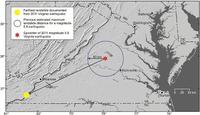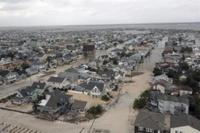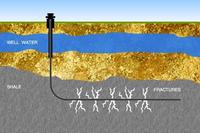-
Dealing with power outages more efficiently
When there is a power failure, the utility companies, public officials and emergency services must work together quickly; researchers have created a new planning software product that enables all participants to be better prepared for emergency situations
-
-
Building material of millennium: Autoclave Aerated Concrete

Although widespread rebuilding in the hard-hit New York metro region from Hurricane Sandy has not yet begun, New Jersey Institute of Technology (NJIT) scientists say when the hammers start swinging, it is time to look at autoclaved aerated concrete; the material, best known as AAC, has been heralded as the building material of the new millennium
-
-
Inflatable giant plugs could have saved NYC subway system

Inflatable plugs being developed with funding from DHS, could have saved some of New York’s subway and highway tunnels from flooding during Hurricane Sandy, according to the developers of the plugs; DHS successfully tested a plug earlier this year, using a 16-foot diameter prototype to hold back pressurized water at a test tunnel in Morgantown, West Virginia; the idea was originally intended to protect tunnels from terrorist attacks
-
-
Dutch flood-protection may be suitable for New York, other East Coast cities

Megastorms and disasters are not going to continue to be once in a lifetime storms, but instead become more of an annual occurrence; experts say that the combination of more frequent megastorms and rising sea levels across the east coast would forcemany cities to get serious about flood protection
-
-
Administrations temporarily waives some immigration measures in wake of Hurricane Sandy
The Obama administration has waived immigration laws for illegal immigrants now in the United States, saying that the immigrants’ ability to maintain their lawful status or collect benefits has been effected by Hurricane Sandy; this measure will provide relief for immigrants, but some people are not happy with it
-
-
Long-term sea level rise could cost Washington, D.C. billions
New study projects that the city of Washington, D.C., and federal property in the city, could suffer billions of dollars in damage if sea level rise as a result of global warming increases over the next century. Potential for significant damage will be even greater in the event of extreme weather like Hurricane Sandy
-
-
2011 Virginia quake triggered landslides very far away

The 2011 Mineral, Virginia M-5.8 earthquake was felt over an extraordinarily large area; a new study details landslides triggered by the earthquake at distances four times greater and over an area twenty times larger than previously documented for M-5.8 earthquakes worldwide
-
-
Indian monsoon failure more frequent with warming
Global warming could cause frequent and severe failures of the Indian summer monsoon in the next two centuries, new research suggests; the effects of these unprecedented changes would be extremely detrimental to India’s economy which relies heavily on the monsoon season to bring fresh water to the farmlands
-
-
NY, NJ brace for nor’easter
East Coast resident are still coping with the destruction wreaked by Hurricane Sandy, but now they have to prepare for another potentially destructive storm – a nor’easter which is expected to hit New York and new Jersey on Wednesday; the nor’easter will likely stay 50-100 miles off shore, but its western edges will bring winds of up to 55 mph, coastal flooding, up to two inches of rain along the shore, and several inches of snow to Pennsylvania and New York
-
-
Housing problems loom large in post-Sandy New York City

As a result of Hurricane Sandy, New York City is now dealing with more than 40,000 people who do not have homes to go back to; Mayor Michael Bloomberg said that the number is the worst possible case given by the Department of Housing and Urban Development (HUD), and 20,000 is a more realistic assessment of how many people are homeless; as of late Sunday, 182,000 residents of New York, New Jersey, and Connecticut have applied for disaster assistance, and $158 million has been approved
-
-
Many NYC buildings to remain closed for weeks, months for clean-up, repairs
Water and winds produced by Hurricane Sandy destroyed mechanical and electrical systems in many commercial and residential buildings in Lower Manhattan; as a result, many buildings in the area are weeks or months away from being repaired and fully operational
-
-
Protecting New York City from storms, surges
Almost a week after Hurricane Sandy hit New York City; people are still picking up the pieces of their former lives; for New York officials, the next step is decide how best to protect New York City from a similar disaster in the future; there are many ideas and proposals, ranging from moveable sea gates, to expanding protective marshlands and wetlands, to creating a system of artificial reefs in the channel along the Red Hook and Gowanus neighborhoods of Brooklyn, made out of rocks, shells, and fuzzy rope that will promote the growth of oysters
-
-
Nuclear energy facilities proved themselves resilience during Hurricane Sandy

There are thirty-four nuclear energy facilities in the area hit by Hurricane Sandy; all of them have responded well and safely to the powerful storm; the industry says that careful planning and preparations days in advance of the storm paid off at all of these facilities
-
-
Hurricane Sandy offered support for reliance on nuclear power
A Scientific American writer is impressed with the way nuclear power facilities were able safely to withstand the wrath of Hurricane Sandy; the lesson he draws from this experience: “Global warming is increasing the probability and destructiveness of extreme weather events like Sandy. (I don’t see the point of dithering over this claim any more.) The last thing we should do in the face of this threat is abandon nuclear energy. If anything, we need more nuclear power, not less, to curb global warming”
-
-
Fracking: fact vs. fiction

In communities across the United States, people are hearing more and more about a controversial oil and gas extraction technique called hydraulic fracturing — aka, hydro-fracking; controversies pivot on some basic questions: Can hydro-fracking contaminate domestic wells? Does it cause earthquakes? How can we know? What can be done about these things if they are true? Experts making presentations at the Geological Society of America (GSA) meeting this week in Charlotte, North Carolina, will address these and related critical questions
-
- All
- Regional
- Water
- Biometrics
- Borders/Immig
- Business
- Cybersecurity
- Detection
- Disasters
- Government
- Infrastructure
- International
- Public health
- Public Safety
- Communication interoperabillity
- Emergency services
- Emergency medical services
- Fire
- First response
- IEDs
- Law Enforcement
- Law Enforcement Technology
- Military technology
- Nonlethal weapons
- Nuclear weapons
- Personal protection equipment
- Police
- Notification /alert systems
- Situational awareness
- Weapons systems
- Sci-Tech
- Sector Reports
- Surveillance
- Transportation
Advertising & Marketing: advertise@newswirepubs.com
Editorial: editor@newswirepubs.com
General: info@newswirepubs.com
2010-2011 © News Wire Publications, LLC News Wire Publications, LLC
220 Old Country Road | Suite 200 | Mineola | New York | 11501
Permissions and Policies
Editorial: editor@newswirepubs.com
General: info@newswirepubs.com
2010-2011 © News Wire Publications, LLC News Wire Publications, LLC
220 Old Country Road | Suite 200 | Mineola | New York | 11501
Permissions and Policies
